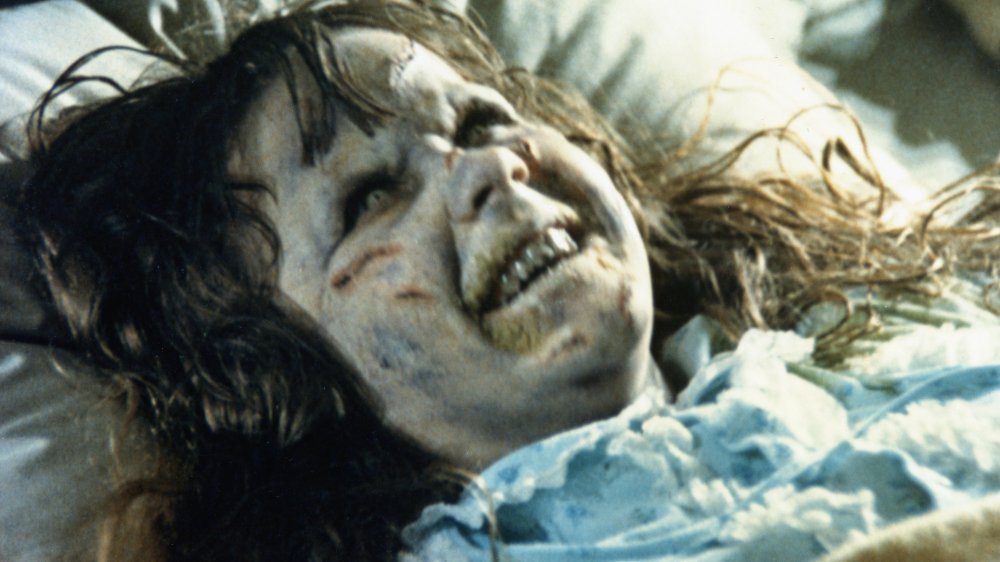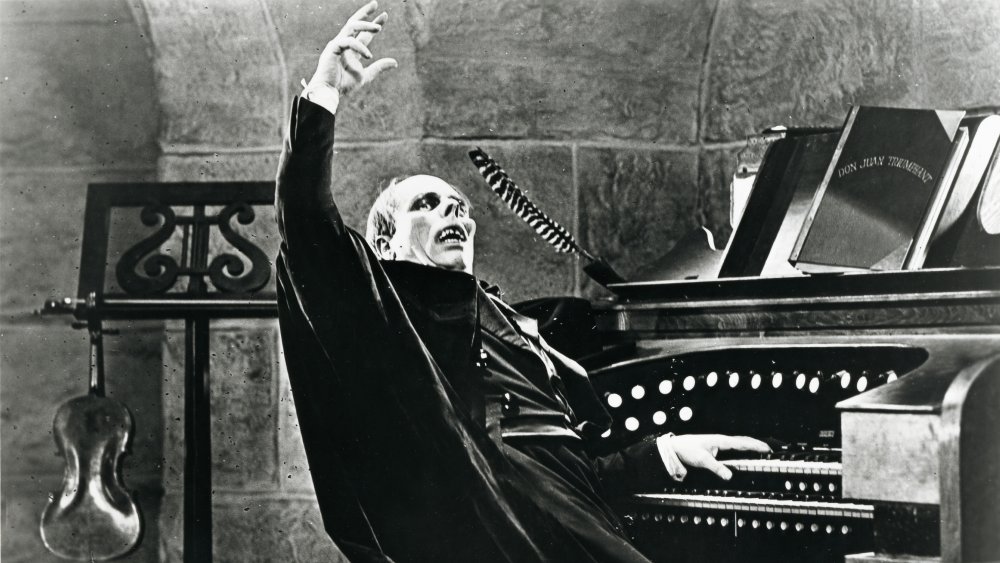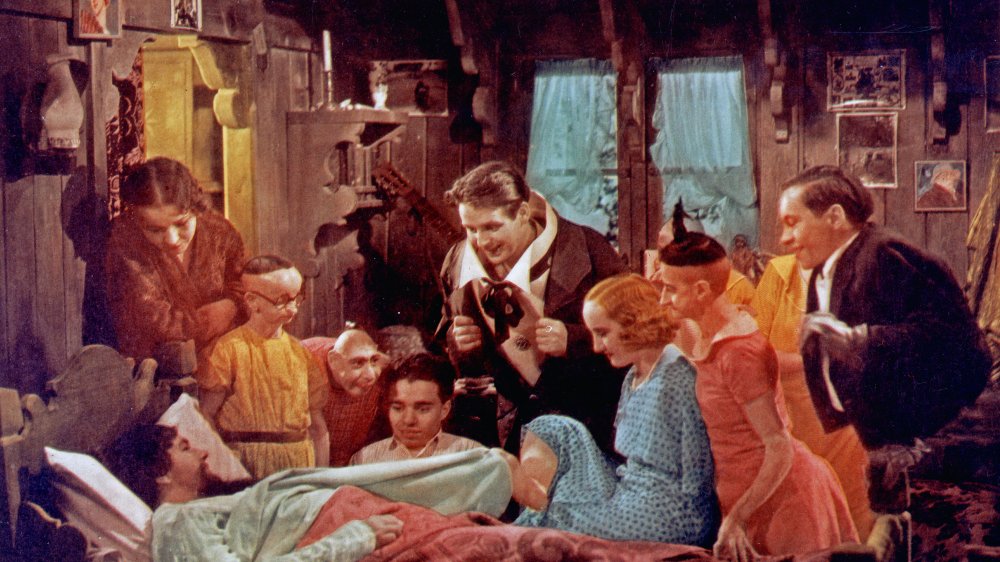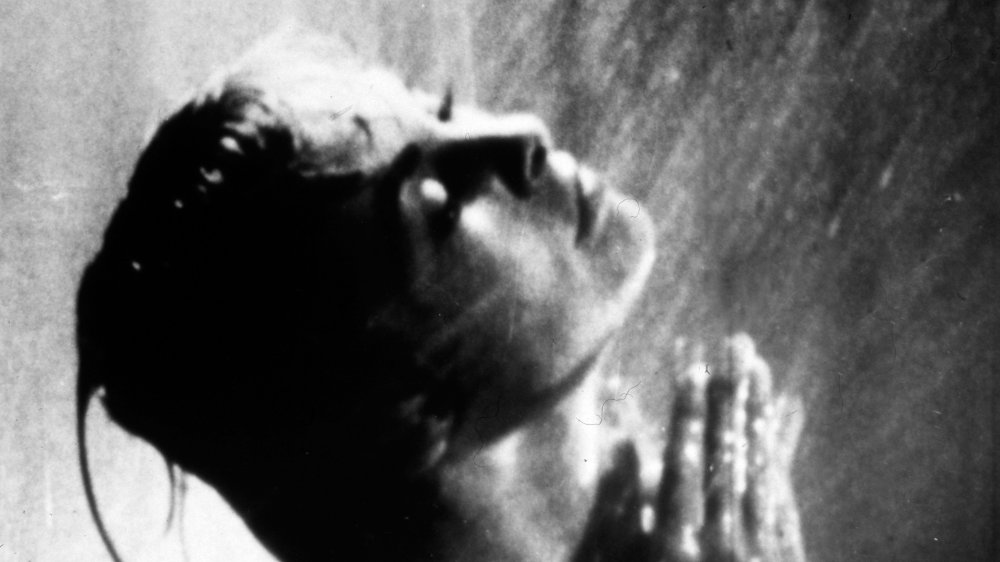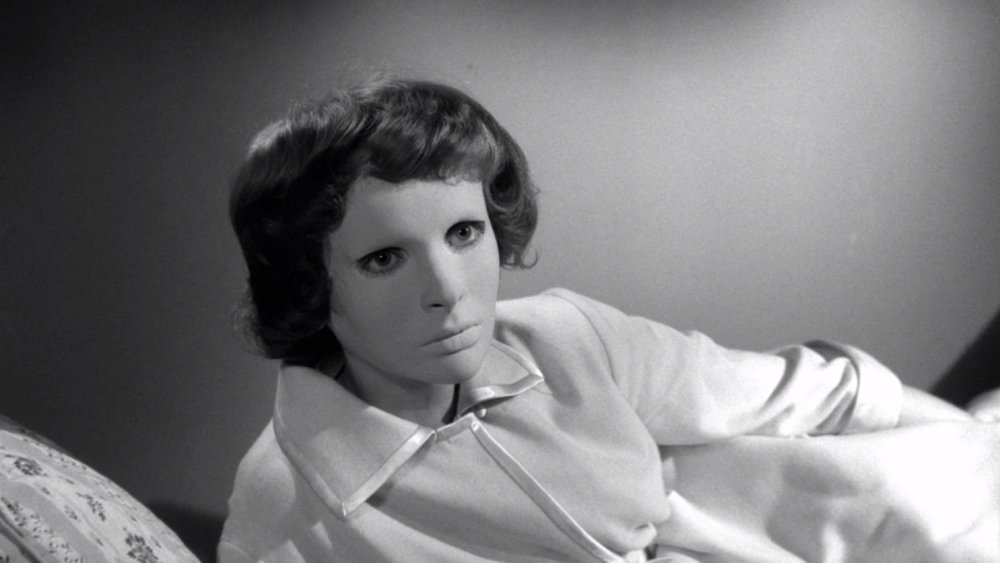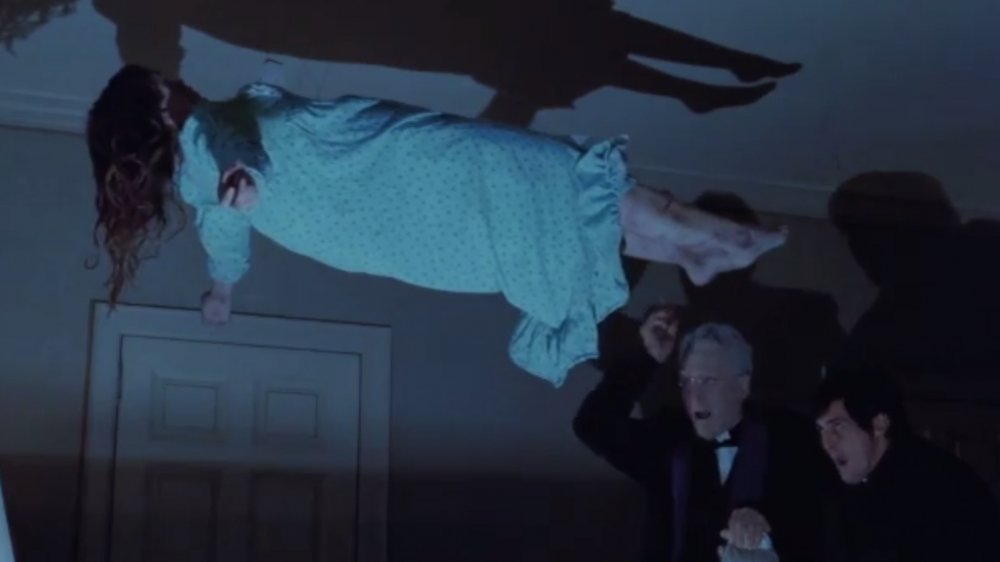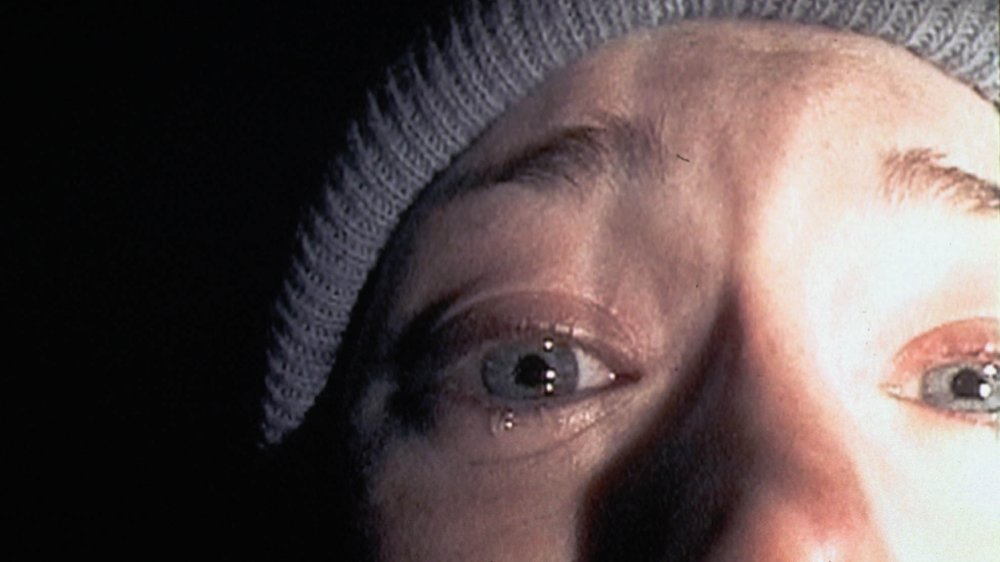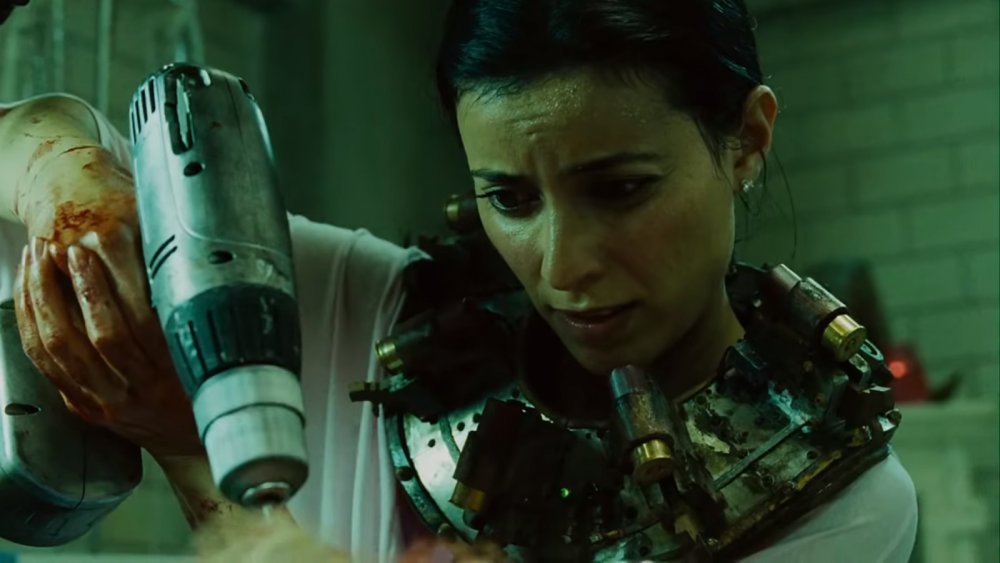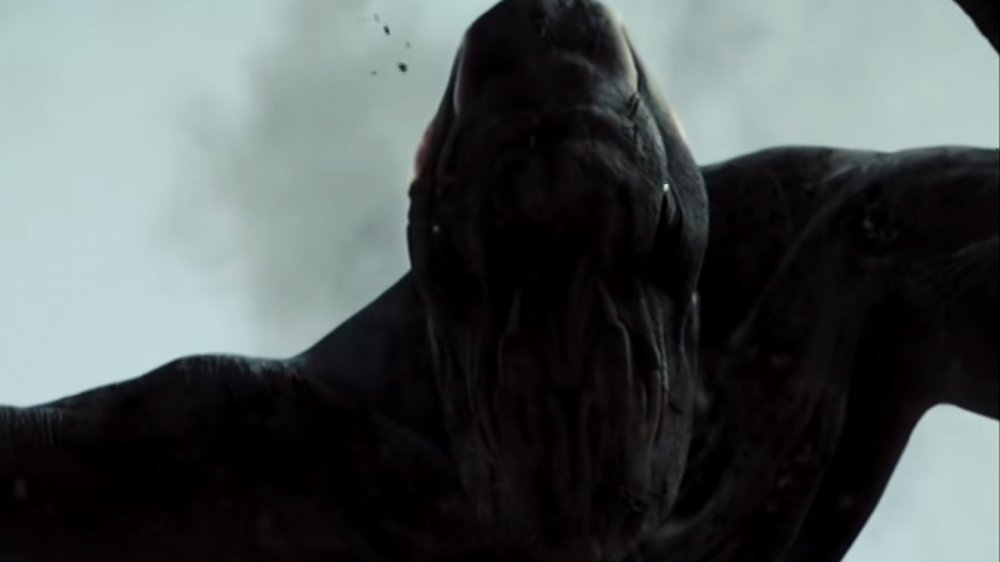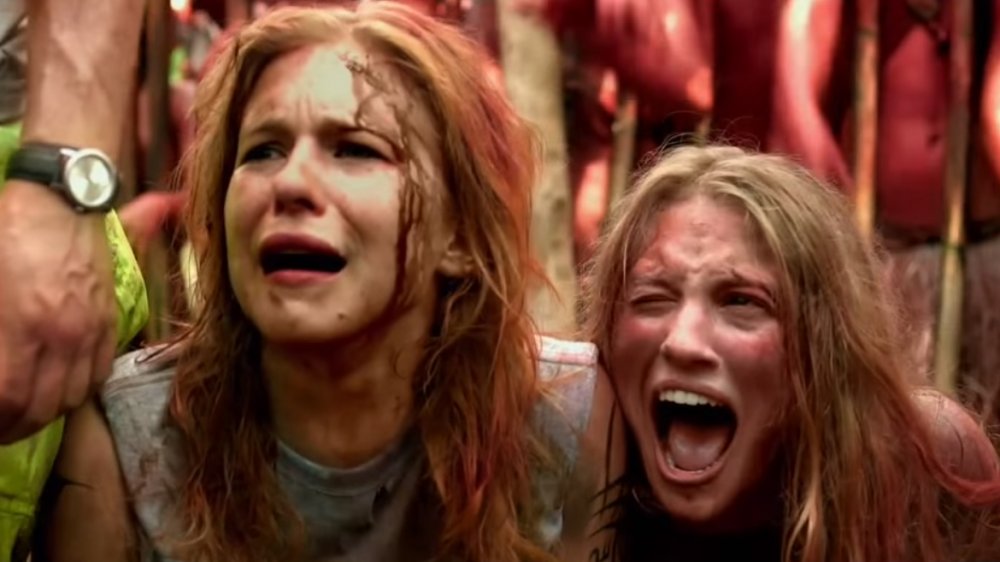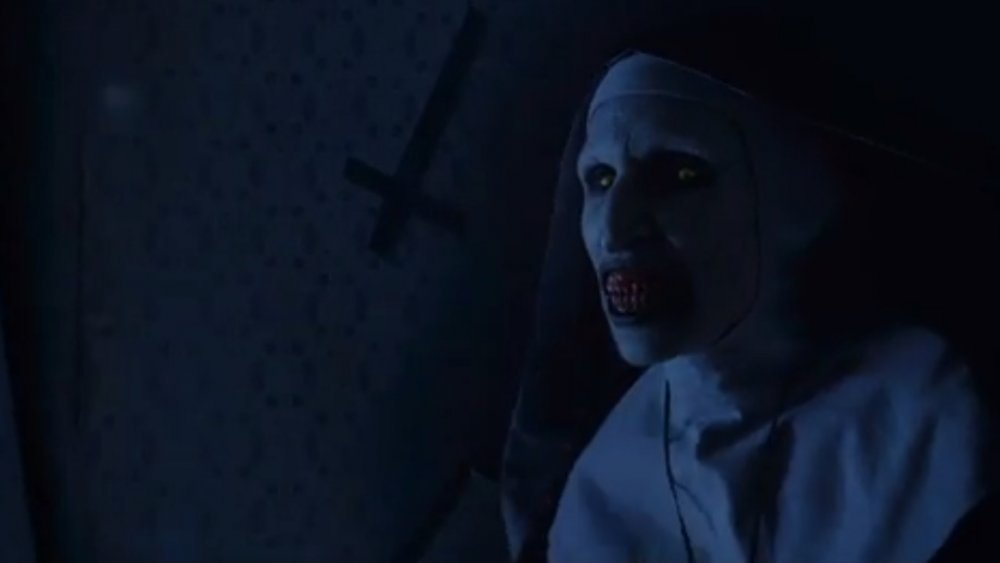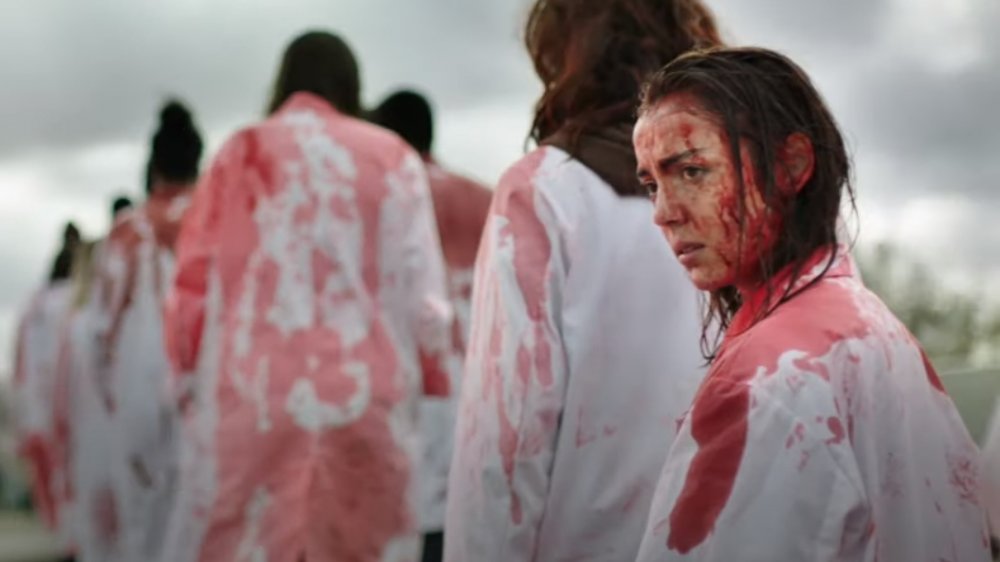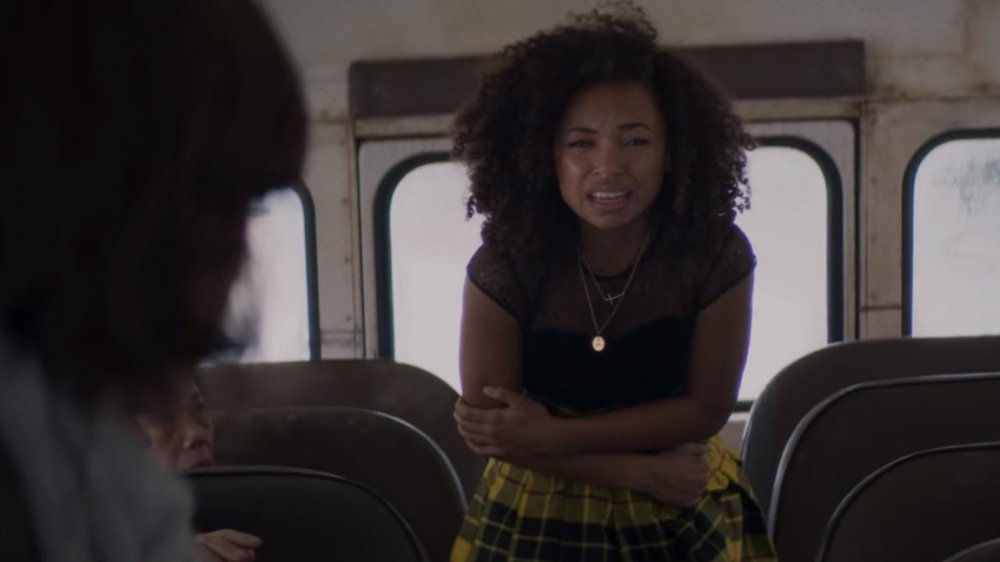Horror Movies That Made Audiences Sick
In his 1981 book Danse Macabre, Stephen King establishes a three-tiered hierarchy for the function of horror in entertainment. On top is terror. Described by King as the "finest emotion," terror is that giddy feeling of suspense and the recognition of the dreaded implications to come. Just below terror is horror. Horror is the shock of seeing the monster for the first time or the pulse-racing jolt of the jump scare. At the bottom, is revulsion, or, as King calls it, the "gross-out." The gross-out is that moment that engages the gag reflex. This is blood, guts, and bile territory where zombies munch on flesh and masked killers eviscerate their victims in fine detail. King himself claims to aim for terror, but he'll settle for horror and will go for the gross-out. "I'm not proud," he writes.
The horror film's ability to evoke a physical response in audiences, whether it's fainting in terror or vomiting in disgust, has long been used as part of hyping the genre. Master of movie ballyhoo William Castle famously stationed nurses in theater lobbies for his 1958 film Macabre. In the grindhouse era, patrons were frequently given promotional "sickness bags" for gory flicks like Blood Feast and The Beyond.
Yet, beyond the hype of lurid ad campaigns and gimmicks, the history of horror cinema is filed with real-life incidents of moviegoers fainting, throwing up, or worse. Try to hold down your popcorn as we look at horror movies that made audiences sick.
Phantom of the Opera (1925)
In Hollywood's infancy, Lon Chaney established himself as a star with a difference. A pioneering artist of silent cinema, Chaney virtually created special makeup effects. Known as the "Man of a Thousand Faces," he used unconventional materials and often painful techniques to contort his features for the monstrous roles that made him famous.
Lon Chaney's ultimate creation and most celebrated role was that of Erik, the elusive madman who haunts the Paris Opera House in The Phantom of Opera. The story of a disfigured musical genius whose doomed love for an opera singer has murderous consequences, the 1925 film is a classic of horror cinema. No doubt, a big part of its reputation lies in Lon Chaney's talents. Kept under wraps by Universal Studios until the film's premiere, Chaney's makeup is hidden throughout the early portion of the film. Gripped in unbearable suspense, audiences experienced Mary Philbin as ingenue Cristine's terror firsthand as she snatches away the Phantom's mask.
Terrifying even by modern standards, Chaney's Phantom gave filmgoers in 1925 the shock of their lives. For some, the sudden revelation was too much to take. According to author Nige Burton of Classic-Monsters.com, the Phantom's unmasking caused "women to scream and strong men to faint." In the decades since the film's premiere, Lon Chaney's cadaverous makeup, with its sunken eyes and skull-like rictus, has become a defining image of classic horror.
Freaks
Tod Browning was riding high after the blockbuster success of his 1931 screen adaptation of Dracula for Universal Studios. The film made actor Bela Lugosi a star, Universal the undisputed home of cinematic horror, and its already well-established director a sought-after commodity. However, Browning's next movie would all but bring his successful film career crashing to the ground.
Inspired by the short story "Spurs" by Tod Robbins, Freaks was to be a horror film the likes of which no one had seen before. Set in a carnival sideshow, Freaks is the story of Hans, a dwarf who's the subject of a cruel plot concocted by duplicitous trapeze artist Cleopatra and her equally evil beau, Hercules the strongman. The conniving couple's plan, however, is thwarted when Hans' sideshow comrades violently intervene. Drawing on his own experience as a carnival performer, Browning cast real sideshow performers with physical anomalies and handicaps in the film. Despite his good intentions, middle America was not ready for Browning's terrifying peek behind the sideshow curtain.
Although, as recounted by genre historian David J. Skal in his 1993 book The Horror Show, Freaks was met with positive notices from movie columnist Louella Parsons and The New Yorker, audience reaction was overwhelmingly negative. One of the most extreme reactions, detailed in a 2015 retrospective by The Guardian, occurred after an early test screening when a woman sued MGM, claiming that the film had caused her miscarriage.
Psycho
Shot on high-contrast black and white film stock with a comparatively low budget — for an Alfred Hitchcock film — 1960's Psycho follows Marion Crane, portrayed by Janet Leigh, a woman on the run after making off with a large sum of money. Tired from the road, she checks into the Bates Motel, whose affable but off-kilter owner is hiding a deadly secret.
Psycho changed the face of horror forever. Based on Robert Bloch's 1959 novel of the same name, which was itself inspired by murderer and graverobber Ed Gein, Psycho represents a firm break with the gothic tradition that had been prevalent in horror movies up to that point. Starring Anthony Perkins as mild-mannered killer Norman Bates, Psycho brought cinematic horror down from the windswept castle and into contemporary, middle-class America. Psycho is horror for adults filled with serious themes, subtext, and shocking violence.
The film's most celebrated sequence, the infamous shower murder, has gone on to become one of the most studied scenes in history. A perfect synthesis of cinematography, music, and editing, the scene is Hitchcock at his unrelenting best. Running just over three minutes, the intense scene proved too much for some viewers. J. Hoberman of The Village Voice writes, "Audiences responded as though trapped on a roller coaster through the spook house, with a convulsive mixture of screams and laughter. People bolted for the doors and fainted in their seats. The mayhem caused one New York theater to call the cops and others to call for censorship."
Eyes Without a Face (Les Yeux sans visage)
The thriller Eyes Without a Face, released in the U.S. as The Horror Chamber of Dr. Faustus, is a stylish French horror film that shocked both critics and audiences in 1960. Directed by Georges Franju, the film stars Pierre Brasseur as gifted plastic surgeon Doctor Génessier. Wracked with guilt after his daughter Christiane (Edith Scob) is horribly disfigured in an auto accident he caused, Génessier is obsessed with restoring her beauty. With the help of his loyal assistant Louise, portrayed by Alida Valli, the mad doctor lures young women to his secluded mansion, where he attempts to graft their faces onto the injured Christiane. Although the surgeries are initially successful, Christiane's body repeatedly rejects the transplanted tissue. With her scarred visage concealed by a featureless white mask, the isolated and lonely Christiane grows weary of her father's attempts to heal her and turns against him.
As detailed by the website Senses of Cinema, the film was lambasted by critics for its graphic effects and horrifying subject matter. Author David Kalat writes in an essay featured on The Criterion Collection, "The movie scandalized viewers so much, the outraged French critical establishment tried to deny that the film even existed. The only English reviewer to admit that she liked it was nearly fired." Audience reactions were of a more visceral nature. According to the French news magazine L'express, "the spectators dropped like flies." At preview screenings in France and Scotland, nauseated and fainting filmgoers were hauled out of theaters on stretchers.
The Exorcist
Considered one of the most frightening films ever made, The Exorcist is a landmark moment in the history of horror. Based on the best-selling novel by William Peter Blatty, who also wrote the screenplay, The Exorcist, directed by William Friedkin, stars Ellen Burstyn as divorced actress Chris McNeil. After playing with a Ouija board, McNeil's daughter, Regan, played by Linda Blair, begins exhibiting bizarre physical changes and behavior. With all medical and psychological options exhausted, McNeil turns to Catholic priest Damien Karras (Jason Miller) for help. Reluctantly determining that Regan's malady is of a supernatural origin, Karras teams with Father Lankester Merrin (Max von Sydow), a veteran exorcist, in a grueling battle of life and death.
Nearly devoid of comic relief or light moments, The Exorcist's effectiveness lies in the seriousness with which it takes its supernatural subject matter. Good and evil are not merely ambiguous concepts but concrete realities in an unending war fought on the battlefield of a young girl's soul.
Aside from the film's skillful direction and brilliant cast, the key to The Exorcist's effectiveness lies in the artistry of makeup artist Dick Smith, whose nauseating effects are enough to put even the most hardcore horror fan off their pea soup. As detailed in a 2016 retrospective at MeTV.com, fainting and vomiting were common occurrences during first-run screenings of the film, with some audience members being hauled off in ambulances. In some theaters, ushers were issued smelling salts to revive unconscious patrons.
The Blair Witch Project
Written and directed by Eduardo Sanchez and Dan Myrick, 1999's The Blair Witch Project revolutionized both filmmaking and marketing. Promoted as the purportedly real recovered footage of three missing film students, the movie follows Heather Donahue, Joshua Leonard, and Michael C. Williams as they become lost trudging through the Maryland backwoods while making a documentary about a horrifying local legend. Largely improvised and shot by the actors themselves on Hi-8 video and 16mm film, The Blair Witch Project has long divided horror fans, who either applaud its revolutionary approach or decry its lack of traditional narrative. Nevertheless, its impact on horror is undeniable in light of the continuing rash of found footage films of varying quality that followed in its wake.
As horrifying as the premise of being stalked by a ghostly witch is, it wasn't The Blair Witch Project's scares that sent some audience members running for the exits. As reported by The Guardian during the film's original release, "[The Blair Witch Project's] stomach-turning power is not caused by a surfeit of blood and gore, but by motion sickness caused by the wibbly wobbly hand-held camera." The vomit-inducing camera work led many theaters to post signs and make announcements that those susceptible to motion sickness should choose another film or leave the cinema at the first sign of nausea. Despite the warnings, moviegoers continued to make life hard for cinema staffers, who, armed with mops and rubber gloves, were forced to deal with the mess.
Saw III
Created by the filmmaking team of James Wan and Leigh Whannell, the Saw series is the story of terminally ill serial killer John "Jigsaw" Kramer and his twisted, moralistic crusade to "rehabilitate" his flawed victims through elaborate games and deadly traps. Labelled "torture-porn" by critics for their protracted scenes of graphic violence, the films reignited the decades-old debate over the desensitizing effects of the genre on audiences. Yet, the movies touched a nerve with fans, who made Saw one of the most popular and profitable horror franchises of all time.
Although all the Saw movies are notorious for sadistic, endurance-testing sequences of blood and gore, the third film, Saw III, released in 2006, proved particularly hard to take for patrons of one UK cinema. As reported by the BBC, the staff of the Cineworld movie theater in the town of Stevenage in Hertfordshire, England, was forced to call emergency services three times during a Friday-night screening of the film. Two fainting adults were treated by medics at the scene, and one woman was transported to an area hospital. According to Matthew Ware, a representative of the East of England Ambulance Service, the incidents put quite a strain on emergency medical personnel. "Taking three ambulances out of the system on a Friday could potentially be a problem," Ware stated, adding, "If you know you're squeamish, don't go."
Cloverfield
The creative team of producer J.J. Abrams, writer Drew Goddard, and director Matt Reeves rebooted the 1950s-style giant-monster-on-the-loose thrills of films like Godzilla and The Beast from 20,000 Fathoms for a new generation with the 2008 thriller Cloverfield. Focusing on a group of friends struggling to survive the onslaught of an enormous, rampaging monster in New York City, the film is shot from the perspective of one of the movie's camcorder-toting characters.
Director Matt Reeves skillfully exploits the found footage style, lending a sense of reality to what, in a conventionally shot film, could easily seem a ridiculous premise. However, just like Blair Witch before it, Cloverfield's shaky cam verisimilitude left audiences feeling seasick.
Sensitive viewers suffered headaches, dizziness, and nausea. Many couldn't last for more than a few minutes before bolting for the exits. "I knew in the first 10 minutes I wasn't going to last through the whole movie," cinemagoer Sam Friedman told ABC News after a New York screening. Complaints and walkouts prompted theater chain AMC to post signs warning, "Due to the filming method used for Cloverfield, guests viewing this film may experience side effects associated with motion sickness, similar to riding a roller coaster."
The Green Inferno
Director Eli Roth burst onto the scene in 2002 with his feature film debut Cabin Fever, a gory body horror film inspired by both 1980s horror movies and a skin infection Roth contracted while horseback riding in Iceland. Mixing humor with stomach-turning special effects, Cabin Fever made Roth one of the leading horror directors of the 2000s and garnered accolades from filmmakers Peter Jackson and Quentin Tarantino, who declared Roth "the future of horror." Known for his extreme approach to the genre, Roth is a lifelong horror fan who wears his cinematic influences on his sleeve.
The Green Inferno, Roth's 2013 homage to gut-munching grindhouse classics like Cannibal Holocaust and Make Them Die Slowly, stars Lorenza Izzo as Justine, a socially conscious college student who joins a group of environmental activists in their efforts to halt a petrochemical company's bid to clear a swath of the Amazon rainforest. However, when their plane crashes in the jungle, the would-be eco-activists find themselves at the mercy of an undiscovered indigenous tribe of cannibals.
According to Newshub, the film's brutal scenes of dismemberment and mutilation caused a woman attending a screening at France's Deauville American Film Festival to faint. When director Roth got wind of the incident, he took it as the supreme compliment to his flesh-eating opus, posting on Instagram, "It's official! Someone FAINTED at @thegreeninferno #deauville2015!!!! Best review ever!!!!"
The Conjuring franchise deaths
Based on allegedly true incidents experienced by paranormal investigators Ed and Lorraine Warren, The Conjuring series has the dubious distinction of being related to at least two deaths. As reported by The Times of India in 2016, a 65-year-old man watching the series' second installment, The Conjuring 2, at a theater in Tiruvannamalai, India, experienced a fatal heart attack. The unnamed man began having chest pains and collapsed while watching the thriller based on the notorious Enfield poltergeist case of the 1970s. Rushed to a local hospital, the elderly man was declared dead on arrival. Adding an appropriately spooky air of mystery to this tragic incident, the man's body disappeared, apparently spirited away by an unknown body-snatcher.
A similar tragedy occurred three years later when a corpse was found in a theater after a screening of Conjuring offshoot Annabelle Comes Home in Thailand. According to The New Zealand Herald, the body of Bernard Channing, a 78-year-old British national, was discovered by a fellow cinema patron after the film concluded.
Following these widely reported incidents, The Conjuring series quickly became the subject of internet urban legends that have inflated the number of audience deaths to as high as 37.
Raw
Raw, the debut feature from French filmmaker Julia Ducournau, stars Garance Marillier as Justine, a freshman veterinary student and strict vegetarian who develops an insatiable appetite for human flesh. After being forced to eat raw rabbit kidneys as part of a vet school initiation, Justine finds herself craving meat. Unsatisfied with raw chicken, she turns to her classmates for sustenance. However, she discovers that she's not the school's only cannibal.
Acclaimed for its innovative script, tight direction, and inspired performances, Raw was hailed as a modern horror masterpiece by Rolling Stone. Still, some viewers may have missed out on some of the finer points of Raw's rich subtext because they were retching their guts out or passing out over the film's highly realistic gore effects.
A 2016 report from The Guardian states that paramedics had to be called to a screening of the movie in Toronto. "An ambulance had to be called to the scene as the film became too much for a couple patrons," Ryan Werner, Raw's marketing representative told the British newspaper. Taking full advantage of the film's growing reputation, the Nuart Theatre in Los Angeles resurrected a classic grindhouse gimmick by passing out souvenir barf bags to eager patrons.
The Perfection
Released by Netflix in 2019, The Perfection is one of the latest horror films to tickle its audience's gag reflex. Directed by Richard Shepard, The Perfection stars Allison Williams, best known for her role on the long-running HBO series Girls, and Dear White People's Logan Browning as a pair of gifted young cellists who hatch a complex plot to take revenge on an abusive sex cult in a prestigious Boston music school. Billed as a "psychological thriller," the film nonetheless packs a heavy, visceral punch.
Featuring an amputation-by-meat-cleaver, insects erupting from flesh, and an utterly disgusting incidence of maggot-infested projectile vomit (inspired by a real-life incident involving director Shepard), The Perfection led sickened viewers to flood social media with their stories of headaches and nausea. As reported by People, one Twitter user posted, "the perfection on netflix is SICK... in a bad way ugh my body can't move and i feel like puking." Another viewer tweeted, "i actually feel physically sick after watching the perfection, i couldnt take the bugs man, i was about to turn the movie off but im glad i didnt..."
